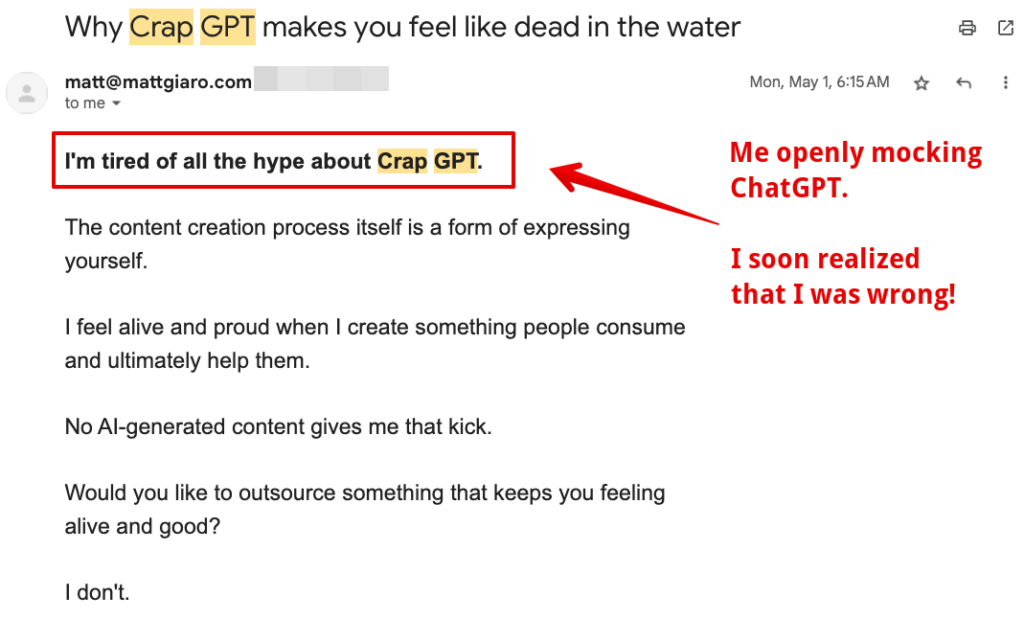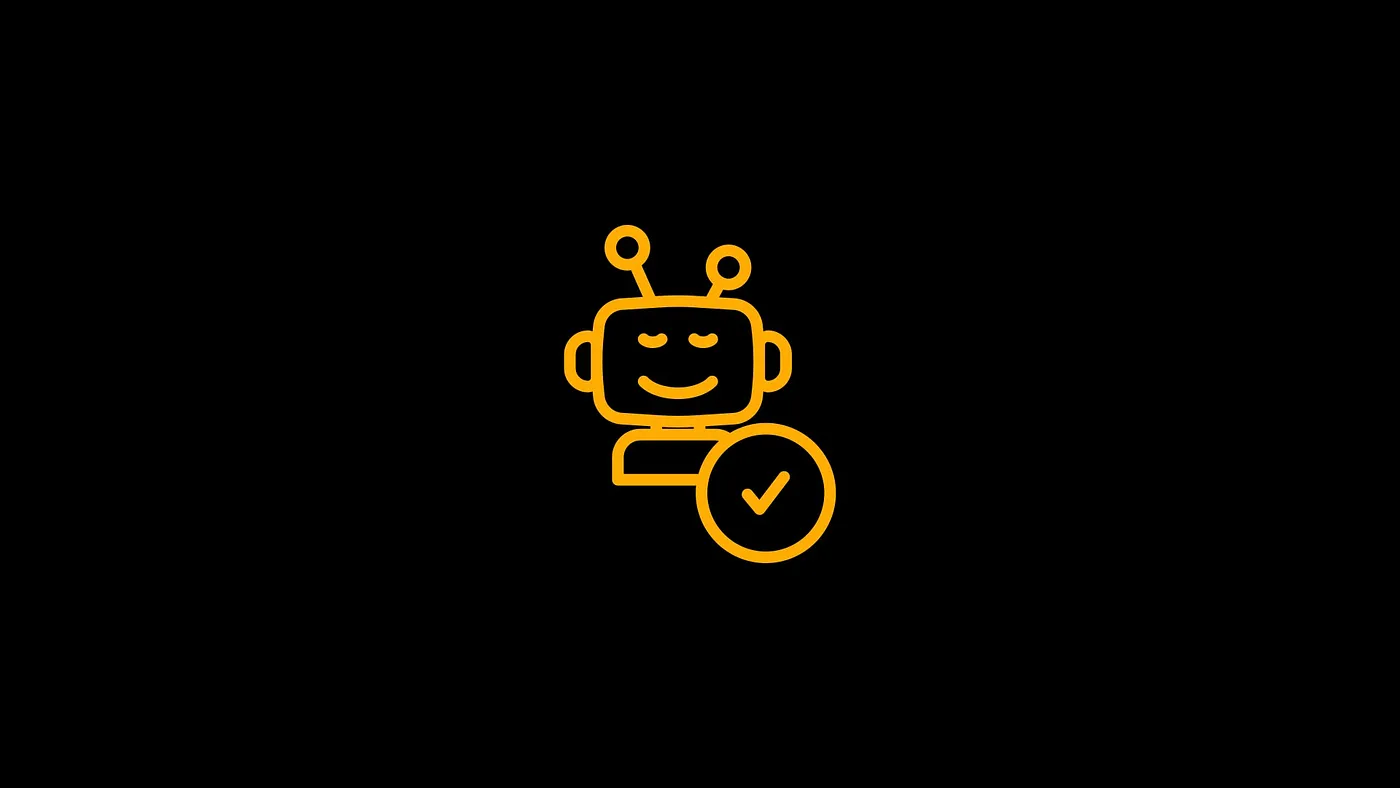Puritan writers will hate me after reading this
I was shocked.
Everywhere I looked, it was all about “GPT-3.5” and how AI is going to revolutionize content creation.
GP… what?
How do you even pronounce that? “Jipt” or “Gee pee tee?”
Like a sheep, I created a ChatGPT account.
I started chatting with the bot, and the replies slapped my pretty face.
WTF?
Was this the “revolution” everyone was talking about?
What it spits out felt like reading a medical textbook. But I was hoping for engaging content that I could put my name underneath.
Out of that frustration, I became a ChatGPT hater.
I started writing articles that AI could never replace human writers. I would even nickname it “CrapGPT” in my newsletter:

But little did I know back then…
Because today I’m using AI every freakin’ day to write.
Best part? Most people didn’t even notice.
It sounds sexy on paper
If you’re anything like my clients, then you don’t have 4 hours a day to spend on creating content.
You’re already neck-deep in a 9–5.
Or perhaps you don’t want to spend 4 hours a day glued to your computer.
Or perhaps, like me, you have physical limitations sitting at a desk.
No matter the reason… you’re looking for better solutions to speed up content creation.
Deep inside, you know that AI could help. You feel that it has the potential, right?
Creating content with AI looks sexy.
You can write more content, faster, any time of the day.
This content can help you build an audience, engage with it, and ultimately also help you sell digital products.
That’s how gorgeous it looks on paper.
But in real life, it doesn’t work out like that.
The results you’re getting out of ChatGPT, Claude, or Gemini are often plain garbage.
Sometimes it’s good, but it just needs a lot of editing.
Out of the box, it’s not the kind of stuff you’d put your name on, right?
You’re excited about what AI can do, but you’re also wary.
- What if it’s too obvious that a machine wrote it?
- What if it lacks the personality and style that makes writing truly resonate?
Everyone with an ounce of ethics who’s dipped their toes into the AI waters has felt this mix of awe and skepticism.
And you’re right.
Out of the box, AI-generated content feels like reading a medical textbook when you were hoping for a novel.
You want content that connects, that feels like it was written by someone with a pulse, not a machine.
Don’t waste your time on this stupid garbage
You’ve probably tried all sorts of tricks to make your AI-generated content less… robotic.
Maybe you’ve also tried feeding the AI more data, thinking that if it just knew more, it would write better. You give it context, examples, and detailed prompts, but what you get back still lacks that human touch.
But somehow it forgot half of your instructions.
Or maybe you’ve thought, “Hey, I’ll just test another AI writing tool — surely that’ll fix it!”
Maybe you’re constantly looking for another AI, buying and downloading all sorts of prompts only to find yourself completely overwhelmed.
Instead of saving time, you’re wasting it.
Spoiler alert: it doesn’t.
Maybe you’ve spent hours tweaking the output, adding a word here, replacing a phrase there, trying to inject some life into what feels like a lifeless pile of words.
And worse, it’s still not quite right.
You end up spending almost as much time editing as you would’ve if you’d just written the damn thing yourself.
It’s like putting a fresh coat of paint on a wall with cracks — it might look better at a glance, but the flaws are still there, just beneath the surface.
Instead of saving time, you’re wasting it.
So there are a few elements that make human writing unique.
Develop your fingerprint
If you want your AI-written content to pass as human, you need to develop a style.
Not just any style, but one that’s unmistakably yours.
Your favorite writers all have a distinct voice, a way of saying things that’s uniquely them. That’s what keeps you coming back.
It’s like your fingerprint — unique to you.
AI, on the other hand, is like a blank slate. It’ll give you the words, but they’ll be flat, generic, and, frankly, boring unless you know how to spice them up.
Without a style, your content blends into the sea of mediocrity. It’s like walking into a room full of people all dressed in the same gray suit. They’re presentable, but no one stands out.
That’s what happens when you don’t put your stamp on the content.
Readers might skim through it, but it won’t stick with them. They won’t remember it — or you.
So the first thing that you want to do is actually feed AI with content you’ve written and ask it to analyze your style.
But when you’re just getting started, you might not have discovered your voice yet.
This is why you should simply start writing a lot of pieces so that you can actually start developing a unique style.
One of the best ways to start developing a unique style is to simply mimic a writer you enjoy reading. You’ll find that as you do this, your own particularity will start to emerge.
So at the beginning, there’s no real shortcut. You just have to put in the reps.
If you’ve already written hundreds of posts, then the task is much easier.
Start by identifying your quirks. Maybe you love a good metaphor, or you’ve got a knack for turning a phrase. Maybe your humor is dry, or you’re a master of sarcasm.
Whatever it is, lean into it. Tell AI to inject more of what you are.
Connect your neurons
AI can only regurgitate stuff it has been fed with.
Want authentic output? Feed it with your ideas.
The ones that are uniquely yours, the ones that come from your experience, your insights, and your way of seeing the world.
You can’t expect a machine to come up with the next big thing in your industry or offer a fresh perspective on a well-worn topic.
That’s on you.
Relying on AI for ideas is like asking a GPS for directions without knowing where you want to go. Sure, it’ll take you somewhere, but it might not be where you need to be.
AI can:
- process data,
- analyze patterns,
- and even mimic trends.
But it can’t generate the spark that comes from human creativity.
So here’s the solution that I’m using to come up with interesting ideas that I can feed AI:
- I’m using a note-taking system to distill everything I learn and connect those notes together using a linking system.
- I consume “unpopular” information in my industry to spark new insights.
- I ask AI something, then see where it goes and brainstorm from there.
Before you even think about running that AI tool, sit down and brainstorm.
- What do you want to say?
- What’s the story only you can tell?
- What unique angle can you bring to the table?
Once you have those ideas, then — and only then — should you let the AI help you flesh them out.
Think of it as your assistant, not your boss.
Never write without this
Before you even sit down to write, you need an outline.
An outline is your roadmap — it tells you where you’re starting, where you’re headed, and how you’re going to get there.
An outline is the difference between a cohesive, engaging, and authentic article and a disjointed jumble of words.
Without it, you’re flying blind: your content wanders, and so does your reader’s attention.
They’re left trying to piece together your message, and trust me, they won’t stick around long enough to figure it out.
They’ll click away.
Take a look at this article: Each subsection is about one idea.
I prompted AI with those ideas before even hitting “generate.”
Don’t be one of those dumb writers
Most people are lazy.
They want AI to write their piece from start to finish.
But AI isn’t a magic wand. It’s more like a diligent assistant — great at handling the grunt work, but it still needs your guidance to get things just right.
The problem comes when you treat AI as the writer instead of the assistant. You might be tempted to take what it gives you and run with it, thinking that it’s good enough.
Newsflash: It’s not.
So, don’t be a lazy larvae.
Take a few extra minutes and edit what AI gave you. Be grateful for the 2 hours it saved you writing your shitty first draft.
Those extra few minutes you spend editing can be the difference between content that’s forgettable and content that leaves an impact.
Think of the AI as your first draft. It’s a starting point, not the final product.
PS: Did you notice? In the title, I said, “How to write with AI.” Because it’s a collaborative task.
Want to write more authentic content faster with AI?
Get my free AI-course below:

